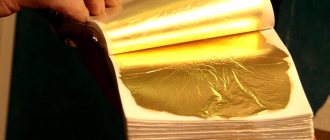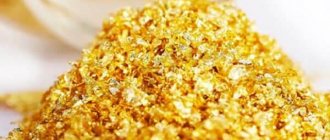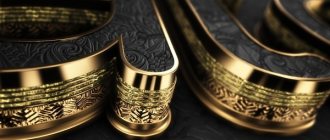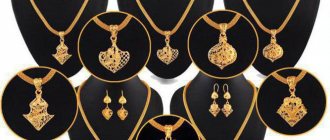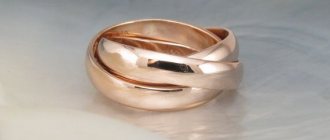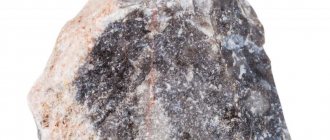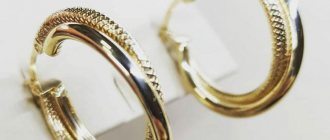It is believed that gold is the first metal with which man became acquainted in history. It is not surprising, since the main method of its extraction is to search for ore in its native state. This noble yellow metal is used not only as jewelry. The domes of churches and crosses playing in the sun, the decoration of majestic icons, the decoration of external elements of buildings, as well as the framing of high-status furniture and other interior items - the technology of gilding the surface with gold leaf is most often used.
Fields of application of gilding
Gilding is used in many areas of our lives - it is performed for protective, decorative, protective and decorative purposes. In particular, plating with 18 and 24 carat gold allows you to give a status look to jewelry made from silver or metal alloys, and also helps restore the beauty of gold items that have lost their original appeal.
Gilding of decor and household items improves the interior of apartments and houses - door handles, forks and spoons, taps, picture frames, metal parts of lamps, etc. are subjected to the procedure.
There is an increasing interest in gilding moldings, chrome inserts, car grilles, handles, and key rings. Plating discs with 24 carat gold, 18Kt/750, 14Kt/585 is practiced.
White, pink, and green gold plating is used in musical instruments, awards, and sports accessories. The gilding of engravings, cigarette cases, lighters, flasks, weapon parts, etc. deserves special attention.
The thinnest layer of gold is sprayed onto car, window and stained glass glass to control heat transfer in winter and summer. Gilding is used in dentistry. It is widely used in microelectronics.
The technology involves the following main steps:
- choosing a gilding method and preparing everything necessary for its implementation;
- degreasing and surface etching;
- coating;
- finishing treatment.
In addition to sputtering the noble metal in its pure form (24 carats, 999 standard), plating with yellow, white, pink, red and green gold is practiced. The alloying additives used are cobalt, rhodium, copper, and silver (nickel). Instead of 24-karat metal, it is plated with gold of 18, 14, 12, 10, 9, 8 carats - the number means the weight units of pure gold in 24 parts of the alloy.
Technology of coating objects with gold leaf
Gold coating of plastic, wood, metal and other materials is carried out using the thinnest sheets - the thickness of gold leaf (cladding) is 0.13-0.67 microns. In the old days, gold leaf was made by hand, today special equipment is used. Depending on the thickness of the sheet, free and transfer (on silk paper) gold leaf is distinguished. It is very difficult to work with the first one - the slightest breath interferes with the process. The finished material is stored in little books - each of the 60 sheets is covered with paper. Applying gold leaf is a painstaking process. The technology is based on the ability of gold rolled out from a sheet to be attracted to the surface at the molecular level. There are two techniques for gilding with gold leaf: glue (for polyment) and oil (for Mordan varnish). In the first case, a glossy surface is obtained, and in the second, a matte surface. The adhesive method is used when carrying out interior work.
Where is it used
Applying gold leaf to monuments, paintings, icons, etc. - the most basic and practical way to use gold plating. And it’s not even that casting gold objects is much more expensive, especially considering the scale of objects like domes or fountains. Thanks to tinsel, you can create interesting and, as it seems at first glance, impossible masterpieces!
The degree of gilding of different objects is not always the same - it depends both on the skill of the craftsman and on the type of product being finished. So, for example, gold leaf with a thickness of 0.36 microns is applied to icons, and on domes the layer will be thicker - about 1.6 microns.
Created gold is made from tinsel sheets. This is the name given to microscopic particles of metal in powder form, which are used for decorating and restoring icons and paintings.
Currently, temples and churches are practically not covered with gold leaf. Leaf tinsel is being replaced by cheaper materials, which are also better in a number of qualities.
Edible gold leaf
Since such a thin metal does not have sharp cutting edges, and a high standard means a minimum of impurities, the question arises: is gold leaf safe to eat?
Gold leaf is used quite widely in cooking. It even has its own food additive number - E175. In many elite restaurants in India you can try gold-plated cakes and pastries, in Japan you can drink gold-plated coffee, and in Europe you can find elite alcohol with gold leaf flakes. So, for example, in Armenia you can encounter Zolotoy cognac, in Ukraine - with Polubotka Zoloto vodka, and in Italy - with Goldschläger schnapps.
Electroplating
The galvanic gilding process is the most commonly used process today. It is applicable when processing conductive products is carried out. The electrolyte becomes a solution of gold salts. A part is immersed in it - when a current passes, positively charged particles released from metal salts settle on the surface of the product and form an even layer of gold.
An even better result can be obtained using the selective method of electrochemical gilding. The use of this technique makes it possible to increase the rate of metal deposition on the product tens of times. The wear resistance and hardness of gold coating increases by more than 3 times. Gold penetration occurs at the molecular level. Electroplating methods are used in gilding souvenirs, jewelry, dentures, etc.
Immersion gilding technique
This type of gilding does not involve the application of external current. When a part is immersed in a solution of a less electronegative metal, the process of immersion deposition occurs. Once the contact exchange ends, it ends. The technology includes several stages - work begins with acidic surface cleaning and micro-etching, and ends with chemical deposition of a nickel layer and subsequent application of immersion gold. The technology is used in the production of printed circuit boards, component terminals, housings, microcircuits and other products that require ultrasonic welding or soldering.
Methods of chemical gilding
At home, gilding of decor, gold coating of spoons, decorative flowers and other metal objects is carried out by rubbing their surface with gold chloride paste or immersing them in a solution with a zinc contact. In the first case, gold is dissolved in a mixture of nitric and hydrochloric acids (1:3). The ratio of gold and solution is 1g/10 ml. The liquid is evaporated, observing safety precautions. The resulting gold chloride is combined with melted (extracted) chalk, cream of tartar and blood salt. After applying the paste with a brush, the object is left for a certain time. It is then washed and polished. By mixing gold chloride with ether, patterns and inscriptions are made.
To prepare a solution for gilding from gold chloride, distilled water (its temperature should be about 50-60 degrees), potash and salt are combined with it. A degreased, acid-etched and water-washed object is immersed in the solution and touched with a zinc stick. Once the gold deposition process is complete, the item is washed and polished. To delve into the details of the technology, it is worth watching a master class on gilding.
Part 3. How to become a specialist in gilding using gilding leaf technology?
After studying the technology of gilding, we realized that the profession of a gilder, excuse the pathos, is a gigantic amount of work, enormous patience and incredible skill. Therefore, the price of gilding has always been very high.
How to become a gilder? We read that this profession was previously taught in some schools. Nowadays, this profession is mainly acquired either independently or under the guidance of already accomplished masters. There are advertisements for training in this craft. The price of training is 3000 rubles per hour. You can go to Germany, there are courses there too. But even if you become an apprentice gilder, this does not mean that you will eventually become a good gilder. In private conversations with gilders, we heard that not every master wants to share his secrets. This means that you will have to comprehend all the wisdom yourself. Here is a quote from an article in the Jewelry News magazine: “Each craftsman has his own recipe for the glue used to glue gold foil. The team often consists exclusively of relatives or members of the same family. There are not many gold plating specialists in the world; it seems that they all know each other. However, trade secrets certainly remain." (https://www.jewellerynews.ru/pages/article4-297.html)
FunChrome Gold plating technology
Pencil gilding
Another “home” method is to use a galvanic pencil in which the tip serves as the anode and the surface of the product as the cathode. The principle of deposition is similar to the electroplating method, but the equipment used eliminates the use of a solution bath.
Noble metal not only decorates products, but also performs protective functions. The gilding process should be entrusted to professionals - lack of experience and the use of dangerous components often leads to undesirable consequences.
4.5 / 5 ( 105 votes)
Gold plated. Why is professionalism important?
How long can gold leaf last? Much, of course, depends on operating conditions. For example, if a gilded sculpture stands in a fountain, the period is also short. It all depends on the amount of sand in the water jets. And many more different factors - snow, ice, wind with sand and other atmospheric phenomena. Under such influences, it is often not the gold that “suffers”, but those materials that are under the gold - primers and varnishes that can crack, swell, and the like. If gilding is done indoors, then naturally the service life is much longer than outdoors. But even indoors, you need to be careful when cleaning gilding. If it is not protected with varnish, you can even wipe it off with your finger. And never let grandmothers with a rag get close to the gilding.
Facts are often cited - look, such and such a palace with gilded domes or statues. Fifty years worth and still like new. And people tend to think that since it is gilded, it really will last forever. No. We talked with clergy and often heard complaints that they had not served for ten years. It turns out that everything depends not only on the gold or its thickness, but also on the hands that apply this gold. In principle, as in any business - although professionals are expensive, they last forever, while others are cheap, but last for a year. In addition, each gilding master has his own innovations and improvements to ancient technologies. And these innovations are not always for the better. Therefore, it is very difficult to talk about the exact service life of gold leaf, especially if it concerns outdoor products.
FunChrome Gold plating technology
Gold plating and durability. Scientific opinion
As confirmation of our conclusions, we present several quotes from an article by Nikolai Olgin from the Jewelry News magazine. We recommend that you read it all. https://www.jewellerynews.ru/pages/article4-297.html
“Gold leaf technology, which involves a large amount of fine manual work at each stage, today remains one of the most expensive and even cumbersome. Experts justify this by saying that gold coatings do not require restoration for decades, or even centuries. However, when this year in St. Petersburg the figure of an angel was removed from the spire of the Peter and Paul Cathedral for restoration, they saw that the gilding on it seemed to have been erased with sandpaper. But the last time an angel was gilded was only six years ago. It turned out that the finest gilding does not last long in an aggressive urban environment - at an altitude of 122.5 meters, winds with sand particles, rain and smog literally “ate” the precious coating.”
FunChrome Gold plating technology
“Aurum is a long-tested and studied metal,” says Alexander Gnevko, professor at the Department of Materials Science at the Peter the Great Military Academy. – Its protective and decorative qualities are well known. But this material is expensive and soft. Gold leaf wears out from water and dust, even purely mechanically. But nevertheless, the tinsel lasts a long time, but the glue under it ages. Perhaps this is why in St. Petersburg there have been cases of reduced service life of leaf coatings. Titanium nitrite is cheaper and more durable. This was tested by its long stay in sea water. But it darkens due to the oxide film that forms and changes reflectivity. The aging process of titanium nitrite has not yet been sufficiently studied; there is no experience of long-term operation of such a coating. Therefore, there are no real prospects for replacing gold leaf yet.”

